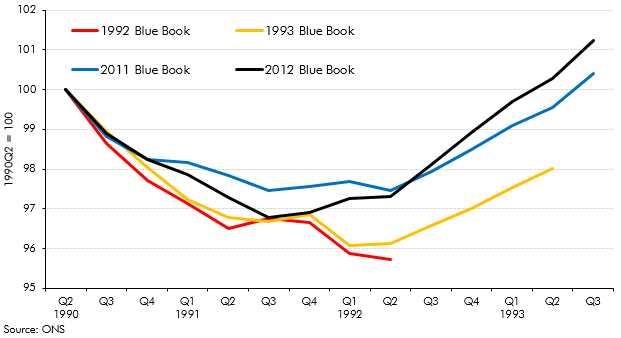Each year, the ONS publishes the National Accounts ‘Blue Book’. The revisions it contains are often a source of revisions to our subsequent forecasts. In this box, we illustrated the scope for history to be rewritten by exploring how the reported pattern of the recession and recovery of the early 1990s had evolved between the Blue Books published shortly after the recession and the most recent Blue Books available at the time.
This box is based on ONS GDP data from July 2012 .
Chart A shows the estimated path of GDP from the second quarter of 1990 as recorded shortly after the recession ended, in the 1992 and 1993 Blue Books, as well as in the two most recent Blue Books, in 2011 and 2012. The 1992 Blue Book suggested that the economy shrank by 4.3 per cent from peak to trough and that there was a double-dip recession after a brief recovery at the end of 1991.
The 2011 vintage of data showed a much smaller peak-to-trough decline of 2.5 per cent and no double dip. This year’s Blue Book has revised the decline back up to 3.2 per cent, although it also shows a significantly stronger recovery. The latest data suggest that all the loss of GDP during the 1990s recession had been recouped by the second quarter of 1993, while the National Accounts published at the time suggested that only half had been.
Chart A: The changing profile of the 1990s recession and recovery

It is impossible to predict whether we will see a similar pattern of revisions to the most recent recession and recovery. As we discuss below, a shallower recession and a stronger recovery to date would certainly appear more consistent with the relatively strong performance of the labour market over the same period.
The ONS has published two studiesa of its GDP revisions and concludes that “neither study identified significant bias”.b But these studies look at revisions between the preliminary estimate of GDP and the estimate published two Blue Books later. The largest revisions to the early 1990s came in the 1998 Blue Book – reflecting new business survey data, a new vintage of the European System of Accounts and rebasing of the data to 1995 – and subsequently. Such later revisions tend to be prompted by methodological changes more than by new or corrected information.
